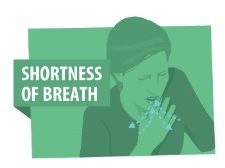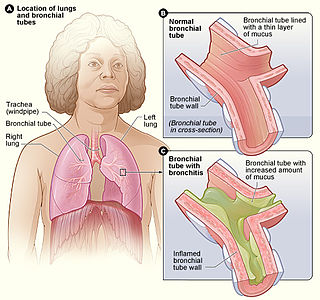Related Research Articles

A respiratory therapist is a specialized healthcare practitioner trained in critical care and cardio-pulmonary medicine in order to work therapeutically with people who have acute critical conditions, cardiac and pulmonary disease. Respiratory therapists graduate from a college or university with a degree in respiratory therapy and have passed a national board certifying examination. The NBRC is responsible for credentialing as a CRT, or RRT,

A cough is a sudden expulsion of air through the large breathing passages which can help clear them of fluids, irritants, foreign particles and microbes. As a protective reflex, coughing can be repetitive with the cough reflex following three phases: an inhalation, a forced exhalation against a closed glottis, and a violent release of air from the lungs following opening of the glottis, usually accompanied by a distinctive sound.

Shortness of breath (SOB), also medically known as dyspnea or dyspnoea, is an uncomfortable feeling of not being able to breathe well enough. The American Thoracic Society defines it as "a subjective experience of breathing discomfort that consists of qualitatively distinct sensations that vary in intensity", and recommends evaluating dyspnea by assessing the intensity of its distinct sensations, the degree of distress and discomfort involved, and its burden or impact on the patient's activities of daily living. Distinct sensations include effort/work to breathe, chest tightness or pain, and "air hunger". The tripod position is often assumed to be a sign.
Disease management is defined as "a system of coordinated healthcare interventions and communications for populations with conditions in which patient self-care efforts are significant."

The Healthcare Effectiveness Data and Information Set (HEDIS) is a widely used set of performance measures in the managed care industry, developed and maintained by the National Committee for Quality Assurance (NCQA).

Respiratory diseases, or lung diseases, are pathological conditions affecting the organs and tissues that make gas exchange difficult in air-breathing animals. They include conditions of the respiratory tract including the trachea, bronchi, bronchioles, alveoli, pleurae, pleural cavity, the nerves and muscles of respiration. Respiratory diseases range from mild and self-limiting, such as the common cold, influenza, and pharyngitis to life-threatening diseases such as bacterial pneumonia, pulmonary embolism, tuberculosis, acute asthma, lung cancer, and severe acute respiratory syndromes, such as COVID-19. Respiratory diseases can be classified in many different ways, including by the organ or tissue involved, by the type and pattern of associated signs and symptoms, or by the cause of the disease.
A chronic condition is a health condition or disease that is persistent or otherwise long-lasting in its effects or a disease that comes with time. The term "chronic" is often applied when the course of the disease lasts for more than three months. Common chronic diseases include diabetes, functional gastrointestinal disorder, eczema, arthritis, asthma, cancer, chronic obstructive pulmonary disease, Lyme disease, autoimmune diseases, genetic disorders and some viral diseases such as hepatitis C and acquired immunodeficiency syndrome. An illness which is lifelong because it ends in death is a terminal illness. It is possible and not unexpected for an illness to change in definition from terminal to chronic. Diabetes and HIV for example were once terminal yet are now considered chronic due to the availability of insulin for diabetics and daily drug treatment for individuals with HIV which allow these individuals to live while managing symptoms.
Niagara Falls Memorial Medical Center is a hospital in downtown Niagara Falls in the state of New York, founded in 1895, that has been serving the Greater Niagara region for over 100 years.
The Lyell McEwin Hospital (LMH) is a major tertiary hospital located in Adelaide, South Australia that provides medical, surgical, diagnostic, emergency and support services to a population of more than 300,000 people living primarily in Adelaide's north and north eastern suburbs. It is affiliated with the University of Adelaide and the University of South Australia. It is named after Sir Lyell McEwin.

Bronchitis is inflammation of the bronchi in the lungs that causes coughing. Bronchitis usually begins as an infection in the nose, ears, throat, or sinuses. The infection then makes its way down to the bronchi. Symptoms include coughing up sputum, wheezing, shortness of breath, and chest pain. Bronchitis can be acute or chronic.

Obstructive lung disease is a category of respiratory disease characterized by airway obstruction. Many obstructive diseases of the lung result from narrowing (obstruction) of the smaller bronchi and larger bronchioles, often because of excessive contraction of the smooth muscle itself. It is generally characterized by inflamed and easily collapsible airways, obstruction to airflow, problems exhaling, and frequent medical clinic visits and hospitalizations. Types of obstructive lung disease include; asthma, bronchiectasis, bronchitis and chronic obstructive pulmonary disease (COPD). Although COPD shares similar characteristics with all other obstructive lung diseases, such as the signs of coughing and wheezing, they are distinct conditions in terms of disease onset, frequency of symptoms, and reversibility of airway obstruction. Cystic fibrosis is also sometimes included in obstructive pulmonary disease.
Disease or patient registries are collections of secondary data related to patients with a specific diagnosis, condition, or procedure, and they play an important role in post marketing surveillance of pharmaceuticals. Registries are different from indexes in that they contain more extensive data.
Pulmonary rehabilitation, also known as respiratory rehabilitation, is an important part of the management and health maintenance of people with chronic respiratory disease who remain symptomatic or continue to have decreased function despite standard medical treatment. It is a broad therapeutic concept. It is defined by the American Thoracic Society and the European Respiratory Society as an evidence-based, multidisciplinary, and comprehensive intervention for patients with chronic respiratory diseases who are symptomatic and often have decreased daily life activities. In general, pulmonary rehabilitation refers to a series of services that are administered to patients of respiratory disease and their families, typically to attempt to improve the quality of life for the patient. Pulmonary rehabilitation may be carried out in a variety of settings, depending on the patient's needs, and may or may not include pharmacologic intervention.
Second Opinion, an American television series, is the only regularly scheduled health series on public television. Each week, series host engages a panel of medical professionals and patients in honest, in-depth discussions about life-changing medical decisions. Using intriguing, real-life medical cases, the specialists grapple with diagnosis and treatment options to give viewers the most up-to-date, accurate medical information. The series is produced for public television by WXXI-TV, the University of Rochester Medical Center and West 175 Productions. Second Opinion is made possible with support from the Blue Cross and Blue Shield Association.

Chronic obstructive pulmonary disease (COPD) is a type of progressive lung disease characterized by long-term respiratory symptoms and airflow limitation. Systemic manifestations are known. COPD and asthma may coexist and converge in some individuals. The main symptoms of COPD include shortness of breath and a cough, which may or may not produce mucus. COPD progressively worsens, with everyday activities such as walking or dressing becoming difficult. While COPD is incurable, it is preventable and treatable.
The ÇOMÜ Hospital is the biggest research and teaching hospital in the Western Marmara region of Turkey which serves the area of north Aegean and South-West Marmara regions. The current president and chief executive officer is Dr. Murat Coşar. The hospital is a 160-bed facility that provides patients with a complete range of primary and specialty care services.
The National Hip Fracture Database (NHFD) is a nationwide audit within the NHS concerning the management and outcomes of patients with hip fractures.
The National Confidential Enquiry into Patient Outcome and Death (NCEPOD) is a registered charity based in London. Dr Marisa Mason is the Chief Executive and Mr Ian Martin is the Chair of the Trustees. The organisation started from a pilot study of mortality associated with anaesthesia in five regions in England, Wales and Scotland published in 1982. A joint venture was established between surgery and anaesthesia named the Confidential Enquiry into Perioperative Deaths. It became the National Confidential Enquiry into Perioperative Deaths (NCEPOD) in 1988 and published its first report in 1990. It now covers all specialities and covers all outcomes as well as deaths.
References
- ↑ "hqip team" . Retrieved 31 January 2021.
- ↑ "HQIP board" . Retrieved 24 April 2022.
- 1 2 3 4 "HQIP Trustees Report and Account (1 April 2020-31 March 2021)" (PDF). HQIP. November 2021. Retrieved 29 April 2022.